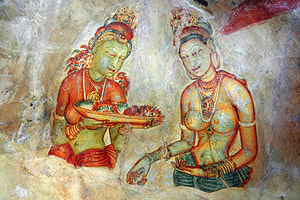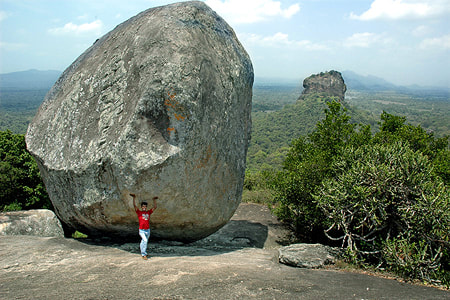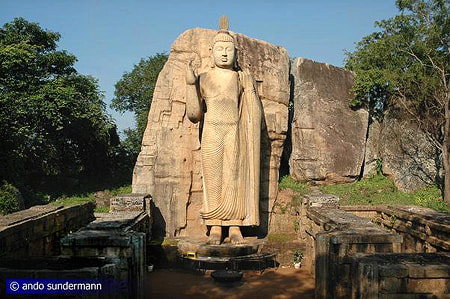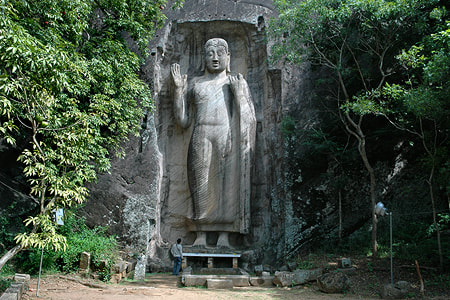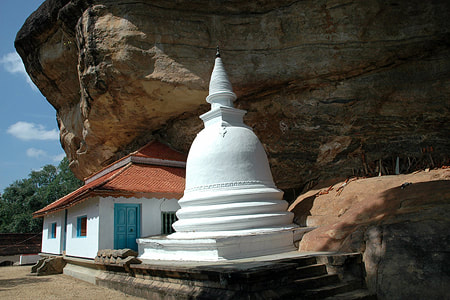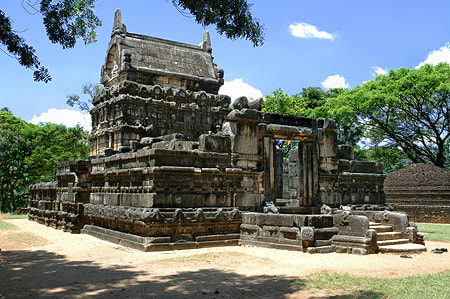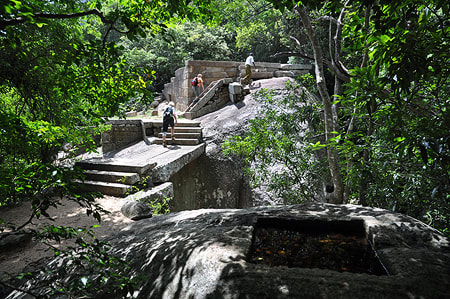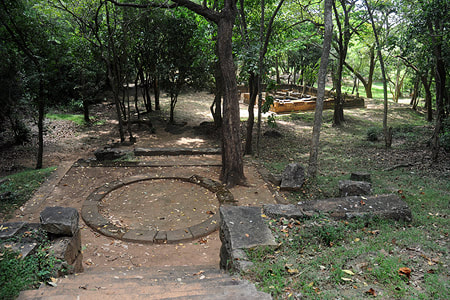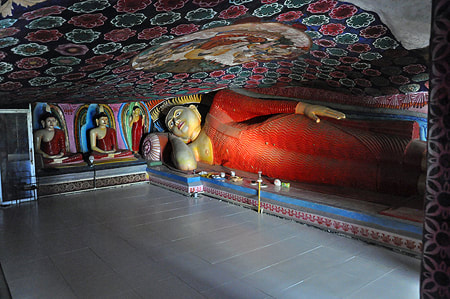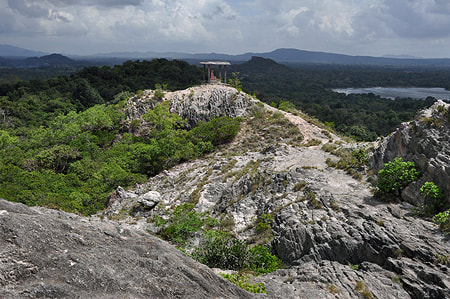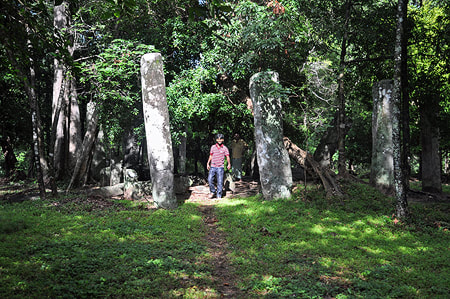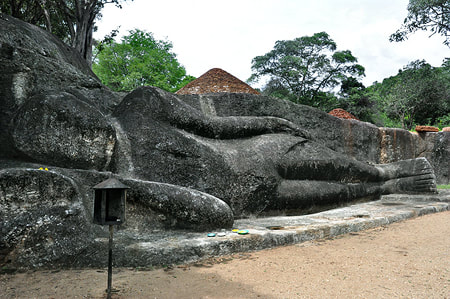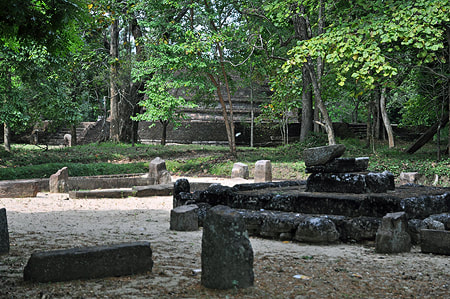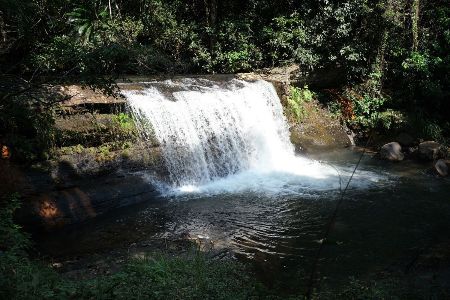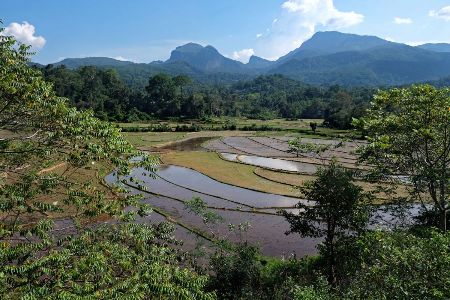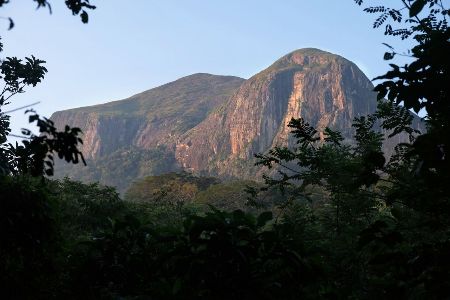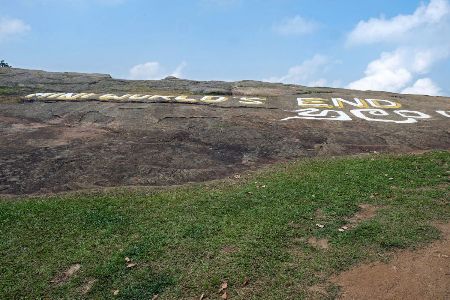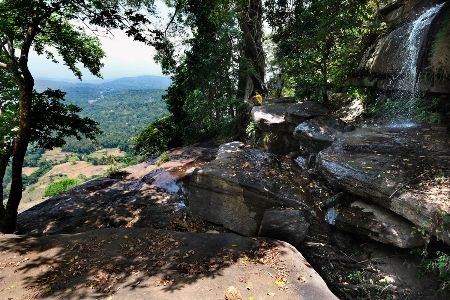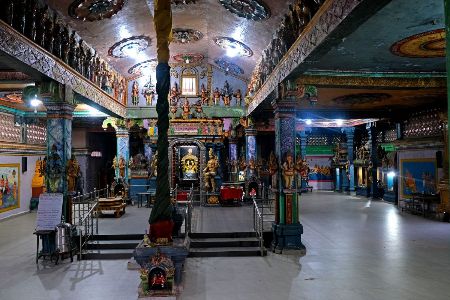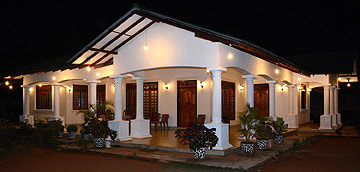Off the beaten path around Dambulla & SigiriyaThis page is about less-frequented places of interest in the
centre of the Cultural Triangle. Find a list of links to dozens of off-the-beaten-path destinations all over Sri Lanka here... |
Popular tourist attractions in the heart of the Cultural Triangle
The World Heritage Sites of Dambulla and Sigiriya form the very heart of the so-called Cultural Triangle of Sri Lanka. Both places, the painted caves of Dambulla and the spectacular palace ruins on the so-called Lion Rock are must-sees for all first-time visitors of Sri Lanka, at least for all heritage travellers. This is why you will find it difficult to avoid the crowds at these two sites. The best chances to be undisturbed are visits just at the opening hours. Some other quite touristy - but nevertheless recommendable holiday activities - in the surroundings of Dambulla and Sigiriya are village tours in Habarana and elephant safaris in Minneriya or Kaudulla National Parks (depending on the season of elephant migration). Apart from these major attractions, there are numerous other places of interest in this amazing area, some of them completely untouched by tourism.
Lonesome places in the surroundings of Dambulla and Sigiriya
|
3***stars & rarely visited
One of the greatest places in Sri Lanka is in only 1 km distance from Sigiriya. It’s the neighbour rock known as Pidurangala. This was the Buddhist monastery outside the city walls of Sigiriya. There is a lot to see in Pidurangala, a ground-level excavation site of typical monastic buildings from the late Anuradhapura period, painted caves with long relining Buddhas, prehistorical rock shelters, a gorgeous recling Buddha made of brick in one of the rock shelters. Most amazing are the vistas from the very top. Actually, the 360 degree panorama from Pidurangala is even more spectaculat than that of neighbouring Sigiriya.
|
|
3***stars & not overcrowded
Well-known and often visited, particularly in the most recommendable morning hours, is the most imposing rock-cut Buddha on the island. It’s known as Aukana Buddha . It’s not the tallest of Sri Lanka’s rock-cut statues, but concerning mass or volume, it’s definitely the largest one and it’s extremely well designed. Hence, it attracts many heritage tourists. Nevertheless it’s not yet overcrowded and can be even lonesome at times. When travelling to Aukana, you will drive the road on the crown of the Kalawewa, which is Sri Lanka’s most famous historical tank, though not the largest one.
|
|
3***stars & rarely visited
The beauty of the rock-cut Sasseruwa Buddha in Rasvehera can not rival that of the more famous „twin“ statue in Aukana. Having said that, we can claim that most travellers like hte Sasseruwa Buddha even more. The reason is the location or the surroundings. The rock surface, from which the Sasseruwa Buddha is cut, is at a natural platform high above the ground level, offering vistas to the wilderness. It’s a tranquil place. And much less tourists than to Aukana also come to visit this equally large statue. Apart from the rock statue, Rasvehera has also some intersting painted caves. And it’s in the middle of a nature sanctuary rich in elephants.
|
|
3***stars & rarely visited
One of the most imposing cave temple in Sri Lanka, second only to Dambulla, is the Reedi Vihara near the village of Ridigama. The silver monastery is worth a detour for several reason. Besides the painted caves, it has a picturesque small temple from the Polonnaruwa period. The Ridivharaya temple is mentioned in some pocket guides and therefore visited by some independent travellers. But busloads of tourists are rarely seen in Ridigama. Most visitors are Buddhist pilgrims.
|
|
2**stars & not overcrowded
Easy to reach is the Nalanda Gedige, which is in only 2 km distance from the A9 main road from Dambulla to Kandy. The Nalanda Gedige is not completely off-the beaten path. But as it is not large, many guided tours don't take notice of it. This may come to a surprise, as the Nalanda Gedige is remarkable for at least three reason. It’s the only ancient temple of Sri Lanka completely built of stone. It’s known as the Abu Simbel of Sri Lanka, as it had to be reconstructed at a higher altitude due to a reservoir project. Last not least, it’s the rare example of a temple on the island that is tantric and has a carving depicting a copulating couple – or more precisely: triple.
|
|
2**stars & not overcrowded
Ritigala near Habarana is another archaeological site which is on the shortlist of many heritage travelers and deserves to be. It’s a quaint place today and once was the largest monastery of a specific kind, inhabited by the mysterioues brotherhood that was called Pansukulikas in ancient chronicles. They were full of disdain for works of art, showing their contempt by ornating only one item with careful carvings, the urinal stones of their monasteries. Nonetheless, the almost megalithic stones of their monastic buildings were hewn precisely and quite elaborately.
|
|
2**stars & almost secret
Another Pansukulika monastery is not far away, only 20 km further west. Astonishingly, the archaeological site of Manakanda, though comparable in size and quality to Ritigala, is missing in most pocket guides. Maybe, that’s the reason why there is why almost never any tourist shows up in Madagama, though it’s really not far away from the traffic hub where the roads from Anuradhapura to Kandy and from Polonnaruwa and Habarana to Aukana and Yapahuwa meet.
|
|
1*star & almost secret
The said village, where the Polonnaruwa road A11 branches off from the main road A9 to Dambulla and Kandy, is Maradankadawala. Hidden behind in paddy fields and at the foot of a hill, but one kilometer west from the busy street is a typical cave temple of Sri Lanka. It’s called Gallenvihara. Actually, this is not a must-see, but could be of interest for those who don’t like long detours for seeing some extras.
|
|
2**stars & almost secret
Namal Uyana is a nature reserve with sparse remnants of an Anuradhapura-period monastery. Some guests fall in love with this place, others are disappointed. There are scenic views from the top of the hill and the streams in the jungle are picturesque at places, too. However, Namal Uyana is remarkable for two items. It is crowded with iron wood, the precious timber Sri Lanka is famous for, and it has the largest rose quartz hill in South Asia.
|
|
2**stars & rarely visted
Kalupokuna, also called Kaludiya Pokuna of Sigiriya, is close to the famous Heritance Kandalama Hotel. That’s why sometimes busgroups or several independent travellers find their way to this archaeological site amidst a nature and bird sanctuary. Nonetheless, chances are not too bad to expereince the beauty of this location completely alone. And it’s a charming place indeed, coming close to picturebook visions of lost temples in the jungles.
|
|
1*star & almost secret
A very rarely visited site is Bakamuna to the southeast of Kandalama. Actually, it is not worth that long detour, because there is only one item of interest, one of the three surviving rock-hewn recling Buddhas in Sri Lanka’s Cultural Triangle, the other one being in Polonnaruwa and Tantirimale. The statue in Bakamuna is smaller in size and less well preserved. It’s only worth a visit, if you must have seen all important sites of Buddhist art or if you take the shortcut via Bakamuna (instead of Habarana) to Gititale and Polonnaruwa.
|
|
1*star & almost secret
Little touristic attention is paid the the archaeological site of Menikdena to the southwest of Dambulla. It’s not spectacular at all. But the ancient monastery is worth mentioning as the best example of a specific type of monastic complexes that were very common in the late centuries of the Anuradhapura perios (7th to 10th century). Menikdena is a classical version of a so-called Pabbata Vihara. Besides, it’s also an arboretum within the excavated area.
|
|
1*star & almost secret
Hiru Ella close to the Kaluganga reservoir and its dam is a very small waterfall, just a little bit more than head high; it's locally also known as "Aliya Wetunu Ella". Visiting it is dangerous, as wild elephants frequent this area.
|
|
1*star & almost secret
Ranamure, a village surrounded by paddy fields, is sizuated between Knuckles Range and the new reservoir of Kaluganga. Ranamure is a possible starting point of Knuckles treks. Ranamure is crossed by the dead end road to Narangamuwa and can be considered an alternative for overnight stays in the northeastern foothills of Knuckles Range.
|
|
2**stars & almost secret
Narangamuwa is a hillcountry village 40 km south of Sigiriya, as the crow flies, situated at the foot of the spectacular Lakegala Mountain. Narangamuwa is much less visited than Meemure, but for the Lakegala (alias Meeriyagolla) trek, it's recommendable to have an overnight stay in Narangamuwa. The village is also the best starting point to Mathalagala alias Matalegala, which is a wonderful view point and a good camping site.
|
|
1*star & almost secret
Hulangala is a peak in the mountain range forming the boundary of Matale District in Sri Lanka's Central Province with Kurunegala District in the North West Province. Below the peak is a mountain saddle with an abrupt drop of a hundred meters. It's called Hulangala Mini World's End. The escarpment is easy to reach on a 2.3 km long trail from the ticket office, which belongs to Selagama Tea Esate.
|
|
1*star & almost secret
Near Hulangala Mini World's End is another attraction situated in the Selagama Tea Estate. Just like the Mini World's End, it's an escarpment, but this cliff called Yatawatta Biso Ella is a waterfall. The main fall cannot be seen from above, but a smaller cascade just above the main escarpment offers an opportunity to walk in a rock shelter behind the veil of a waterfall.
|
|
1*star & almost secret
From a touristical perspective Rattota in Sri Lanka's Matale District is the gateway to Riverston and the northwestern part of Knuckles Range, not far away are the picturesque Bamarakiri Falls. Rattota's town center has a colourful Tamil Hindu Temple called Rattota Kovile. Sri Lanka's only temple didicated to Rama is a smaller temple at Rattota's main street
|
